




July 2020 • Volume 55, No. 4
ANZA ELECTRIC COOPERATIVE
Sherri Stafford
ARIZONA’S GENERATION AND TRANSMISSION COOPERATIVES
Geoff Oldfather
DUNCAN VALLEY
ELECTRIC COOPERATIVE
Steven Lunt
ELECTRICAL DISTRICT NO. 2
Roselyn Bever
GRAHAM COUNTY
ELECTRIC COOPERATIVE
Diane Junion
CURRENTS EDITOR
Mike Teegarden, CCC
Currents (USPS 030-520) is published bimonthly for members for $2.03 a year, plus postage, by Pioneer Utility Resources, 5625 NE Elam Young Pkwy Ste 100, Hillsboro, OR 97124—a notfor-profit Oregon cooperative corporation—to serve the communication needs of 53 consumerowned electric utilities in Oregon, Washington, Alaska, Idaho, Nevada, California, Arizona and Hawaii. Preferred periodical postage paid at Hillsboro, Oregon 97123 and additional mailing offices. ©2020 Pioneer Utility Resources. All rights reserved. Reproduction in whole or in part without written permission is prohibited.
Postmaster: Send address changes to Currents, 5625 NE Elam Young Pkwy., Ste 100, Hillsboro, OR 97124.
TO CONTACT CURRENTS
Mailing address:
5625 NE Elam Young Pkwy Ste 100, Hillsboro, OR 97124
Email: info@pur.coop.
Subscription services: Nonmember subscriptions $8 (U.S.) per year. Prepayment required. Identify local edition desired.
Delivery Issues: Utility members should contact the local utility office listed on the back cover. Nonmembers should contact Pioneer Utility Resources.
Extra copies: $3 each, pre-payment required. Supply is limited. Identify edition, month and year.
Reprint permission: Direct all requests to info@pur.coop.
Manuscripts and photographs: Query first. Do not send unsolicited materials.
DISPLAY ADVERTISING INQUIRIES
American MainStreet Publications
611 S. Congress Ave., Suite 504 Austin, TX 78704
800-626-1181 or 512-441-5200
Welcome to the halfway point of 2020—a year of events no one saw coming. Phrases like stay at home, social distancing and abundance of caution are now part of the vernacular.
Amidst the new normal have come stories of difference-makers. When we adopted the theme of Heroes Among Us for our magazine coverage in 2020, we had no idea how right for the times this kind of storytelling would be.
On the pages ahead, we share the responses from everyday people to the needs of rural foster families when the coronavirus hit. At a time of so much turmoil, it is a reminder of what happens when individuals step up to make a difference. Could this be the real story of 2020?
This month’s centerpiece feature takes a journey back to a time when rural communities did not enjoy electricity as part of daily living. We talk to three witnesses who describe in vivid detail what life was like before and after the lights came on.
The chronicling is a reminder of the importance of capturing memories before it is too late. Along with the article you will find guidance on how to the preserve the memories of your own loved ones.
As we roll into the second half of the year, keep telling us about your heroes. Together, we can write a different story about 2020.
Leon Espinoza Editor

Donors close to home bring essentials, little joys to foster families in need
Page 10
Firsthand accounts of when the lights came on Page 12
Pages: 4-5, 8, 25, 28-29, 32
Signs are going up around town to “Join the List” for Mohave Electric Cooperative’s project to bring high-speed fiber broadband to MEC’s service territory.
Transworld Communications, in partnership with MEC, will build the fiber network and provide internet service.
The “Join the List” message asks members to pre-register to let us know they are interested in the service when it becomes available.
It’s easy to pre-register at MEC’s website, mohaveelectric. com. Pre-registration is not a commitment or contract, but is important to the next steps for the project.
When members pre-register, they are helping TWN and MEC identify the areas of member interest, an important consideration for planning the phases of construction and deployment.
As the internet service becomes available in an area, members who pre-registered will be notified.
It’s a modern-day version of members coming together to help fill a need in the community—just like they did to form Mohave Electric Cooperative in 1946.
Fast forward to now, and MEC’s partnership with TWN on the fiber broadband project.
“TWN also recognizes

the importance of reliable broadband service in rural communities, and demonstrates the same commitment and values that are important to MEC and its members,” says Tyler Carlson, Mohave Electric Cooperative CEO.
The broadband initiative was initially considered when members expressed strong interest in MEC taking on the project. A survey confirmed the level of interest, and was followed by a feasibility study and approval by MEC’s board
of directors to move forward.
Tyler says MEC has cleared several hurdles in the project. Recently, Arizona Senate Bill 1460 passed the legislature and ensures Arizona electric cooperatives have the legal foundation to operate a broadband program.
“We’re making progress, but there’s still a lot of work to be done,” Tyler says.
Several pre-construction steps are underway, including system design, environmental review and permit requirements. More
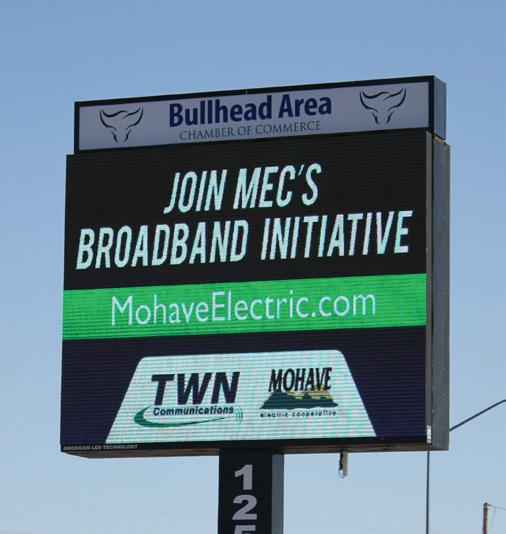
mohaveelectric.com
information and updates are available at MEC’s website, mohaveelectric.com. n
Mohave Electric Cooperative’s board of directors and management thank Arizona Sen. Sonny Borrelli and Reps. Regina Cobb and Leo Biasiucci for their efforts in May to bring SB 1460 to a vote by the Arizona Legislature.
“Their leadership got the job done to make sure this bill was passed,” says Mohave Electric Cooperative CEO Tyler Carlson.
The legislation is necessary for MEC’s broadband project to move forward. SB 1460 passed the Arizona Senate earlier, but was stalled when the House of Representatives cut back on activities due to COVID-19.
“We thank Sen. Borrelli, Rep. Cobb and Rep. Biasiucci





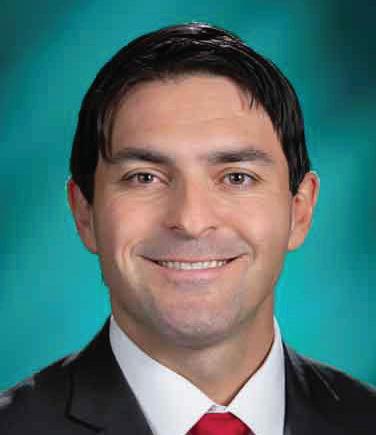
for recognizing the need for high-speed broadband in rural communities and taking the right action to support our members,” Tyler says. n






Put those smart devices to work to improve your home’s energy efficiency and potentially reduce your electric bill
By Paul Wesslund
Before this year’s COVID-19 stay-at-home measures turned business meetings and family gatherings into smartphone conference calls and video conferences, your electric appliances were on the bandwagon of internet-connected energy.
If that makes your gadgets and gizmos sound almost human, well, in some ways, that’s exactly what’s happening.
Talking to a computer isn’t just for Captain Kirk on “Star Trek” anymore. Surveys show about one in four American adults owns a smart speaker or technology such as Amazon Echo, Google Home or Apple HomePod.
We can ask Alexa or Siri to tell us the weather or how to save money on our electric bill. Appliances you control from your phone aren’t just luxury items anymore, says Brian Sloboda, director of consumer solutions with
the National Rural Electric Cooperative Association.
“Two years ago, when you would buy a smart appliance, you were really buying a highend product,” Brian says. “Now, they’re in the middle. More and more appliances are smart, and they have come down in price. It’s everything from lightbulbs you screw into your table lamps, to your microwave, to your washing machine, to your thermostat that you can control through a voice assistant or apps on the phone.”
Brian says those internetconnected devices not only can make you more energy efficient, they can help you take advantage of your electric service in ways you never dreamed possible.
If your machines are acting more like people, you also should take precautions to protect your security and privacy. Smart speakers are on and listening in all the time.
Brian advises you to get in the habit of reading the fine print that comes with instructions and app downloads so you know how your personal information is being used.
As part of his full-time job at NRECA, Brian keeps up with appliance developments. He recently brought a high-tech device into his home.
“My washing machine sends me an email every month
telling me how much electricity it has used,” Brian says. “It gives me tips on how to save energy. It suggests I could wash the clothes in cold water to save energy. It will gently tell you that rather than washing a small load, it’s more efficient to let the clothes accumulate.”
If all that sounds a little creepy, smart speaker manufacturers and marketers understand. They try to encourage customers to get more familiar with their devices. They want you to ask your smart speaker to tell you a joke or play music.
Brian says studies of how people might use voiceactivated devices to manage their energy use show owners like to make those personalized connections.
“Consumers in these focus groups refer to Alexa as their friend,” he says. “They start to give them human attributes. They really do refer to Alexa as ‘she’ rather than ‘it.’”
While apps and speakers can help you use energy more efficiently by alerting you to lights on in rooms you’re not using or suggesting you clean the filter in your washing machine, Brian says smart thermostats offer some of the biggest potential energy savings.
Heating and cooling are among a home’s top energy users. High-tech thermostats

are becoming easier to use and more innovative. These days, they not only can change temperatures for daytime or nighttime, but can track your phone as you leave the house or move from room to room, figuring out your habits and making adjustments based on your lifestyle.
Before buying a smart thermostat, Brian suggests learning about it to make sure it is compatible with your heating and cooling system. Check with

your electric utility, which may have an energy management program with a recommended model or even rebates.
Brian expects smart technology to get even smarter. Utility groups are involved in studies where people describe their values—what is important to them—to their apps and speakers, which respond accordingly.
If saving money is the most important thing to you, your lights might dim in a part of the room you’re not using. If
comfort is your priority, the temperature will stay within a certain range. For those especially concerned about the environment, the dishwasher might delay its start until renewable power is available because the sun is shining or the wind is blowing.
Along with all those benefits comes the need for precautions: Anything connected to the internet can be hacked. That could be a home security system, a baby monitor or a TV.
The first safety step Brian suggests is to change the password on your devices, which come with easy-to-crack passwords such as “1234” or “password.”
He says to check regularly for software updates and install them. They often add protections from the latest cyberthreats.
In addition to security, pay attention to privacy. Many interactions with the internet will collect information on you.
About one in four American adults owns a smart speaker or internet-connected device such as Amazon Echo, Google Home or Apple HomePod. We can ask Alexa or Siri to tell us today’s forecast and how to save on our monthly energy bills. Be sure to protect your security and privacy. PHOTO BY
PAOLESE
A smart speaker is listening to everything that goes on in your home all the time. Reading those tiny-type agreements before you click “accept” might seem like an unrealistic pain, but they generally will tell you what kind of protections are in place to keep your personal information private.
Brian also recommends getting involved in online communities about your internet devices so you can know more about privacy, security and how to get the most out of your smart technology.
“All of these devices generally have some sort of online community for people to engage in and learn from each other,” Brian says. “Folks love talking about their devices—whether it’s a car or a doorbell. People love talking about technology, and they love showing off the things they’ve figured out.”
Brian says new technology is a way to bring people closer as they make better use of their electricity.
“We sometimes look at smart technology and we think it is meant to isolate us, but you can really turn it around and go to in-person meetups or engage online to share tips and tricks,” he says. “I am a real big believer that technology can actually bring us together.” n

MEC provides River Fund $35,000 of extra help for members
Mohave Electric Cooperative’s board of directors approved $35,000 in additional emergency energy assistance funding for MEC’s Members Helping Members program administered by River Fund Inc.
“At this time when members need assistance most, our board wanted to do more to help our members who are having financial difficulties due to the COVID-19 situation,” says MEC CEO Tyler Carlson. “The quickest thing we could do was add funding to MEC’s assistance program that Mike Conner and the River Fund already have in place. We are doubling the annual program funding from $35,000 to $70,000 this year to help members with their electric bill payments.”
“You’ve heard me say this before—I don’t know what we would do without MEC’s programs with River Fund,” says River Fund President and CEO Mike Conner. “When I got the phone call that MEC’s board of directors had approved an extra $35,000, it was welcome news, making it possible to help many more
income-qualified members.”
The 2020 energy assistance program provides $70,000 funded by assigned capital credits, without cost to members as approved in the MEC bylaws.
Mike says MEC facilitated annual funding for several other programs administered by River Fund for many years. Members may donate to From the Heart with River Fund and Operation Round-Up by amounts voluntarily added to their electric payment. MEC employees donate through a payroll program.
Since 2012, MEC has applied each year to CoBank’s Sharing Success program on behalf of River Fund, which received $10,000 in 2020 donated by CoBank to From the Heart with River Fund.
For more information on MEC programs, visit www.mohaveelectric.com and click on member services. Income-qualified members needing assistance with electric bill payments may contact River Fund at 928-704-0039, 1343 Hancock Rd, Bullhead City, AZ. n










































Donors close to home bring essentials, little joys to foster families in need ILLUSTRATION
By Claire Sykes
Somewhere near Corvallis, Oregon, a 6-year-old girl rides her bike, braids friendship bracelets and plays hide-andseek in the yard. Come bedtime, she turns the pages of the storybook her mother reads to her.
But Mom is not the one who tucks her in at night. The two are video chatting, each with copies of the same book. It is a special time for them—apart, yet together. It is a picture of foster care and the impact of silent helpers during a pandemic.
On top of coming from a difficult home life, many foster children are separated from their siblings. Such upheaval and
uncertainty can be even more traumatic for them given the coronavirus, with its added economic, health and emotional stresses for foster families.
In February, My NeighbOR stepped in.
An initiative of Every Child Oregon— a statewide network that connects community members with children and families in crisis, and created as a result of the COVID-19 pandemic—My NeighbOR provides local, rapid and sometimes emergency response to foster families’ basic, tangible needs. This means donors live in the same neighborhoods as the families, giving everything from groceries to bunk beds. So far, My NeighbOR has answered calls from more than 800 foster families and youth in every county in the state.
Since 2012, Portland foster children waiting in caseworkers’ offices have received welcome boxes with things such
things as crayons and night lights. Word spread, and more communities around the state started their own Every Child program. The program also donates goods and services to Oregon Department of Human Services and foster children and families. This structure laid the groundwork for My NeighbOR.
The Contingent—a Portland-based nonprofit that works with communities for the common good—has partnered with the Oregon Department of Human Services to make My NeighbOR work.
“We need government systems and services, but it’s relationships that change people,” says Brooke Gray, executive director of mobilizing community with The Contingent. “It’s really powerful to see the neighbor down the street be the one in the middle to make the connection between someone’s needs and giving to them. That’s what neighborhoods are
designed to do, and My NeighbOR helps to create that infrastructure.”
The program will continue at least through this summer.
Though no one knows what’s ahead, one thing is for sure: “We live in a really generous state,” Brooke says. “The true test is, will communities still be generous when they’re struggling through their own hardships? Yes. And that’s been very encouraging.”
The most popular requests are for groceries, toiletries, baby items and gift cards, as well as “flash boxes” filled with art supplies, puzzles and other fun activities. Big-ticket items—such as beds, bicycles and freezers—go through an internal grant-like review.
Community members have donated more than 100 laptops and tablets to My NeighbOR—the goal is 200—which has teamed up with Portland nonprofit Free Geek, which reconditions and sells used computers and other electronics.
The organization wipes the computers clean of their data and mails them directly to DHS-recommended foster children— from toddlers to teens—for telemedicine wellness checks and video visits with nonfoster family. These computers help fill the gap from school-issued computers that generally can only be used for schoolwork.
Foster families and youth who need donations and those who want to give sign up on My NeighbOR’s secure website. When the program receives a list of needs in the community, volunteers contact those who want to donate.
More than 1,200 people want to give. Brooke says about 95% of needs are met.
People drop off their donations at one of 47 My NeighbOR public anchor sites, such as churches, nonprofit organizations and Court Appointed Special Advocates offices.
Salena Minkler, a grade school special educator in Bandon and a My NeighbOR anchor-site coordinator, says being on call and available is vital because so many needs are immediate.
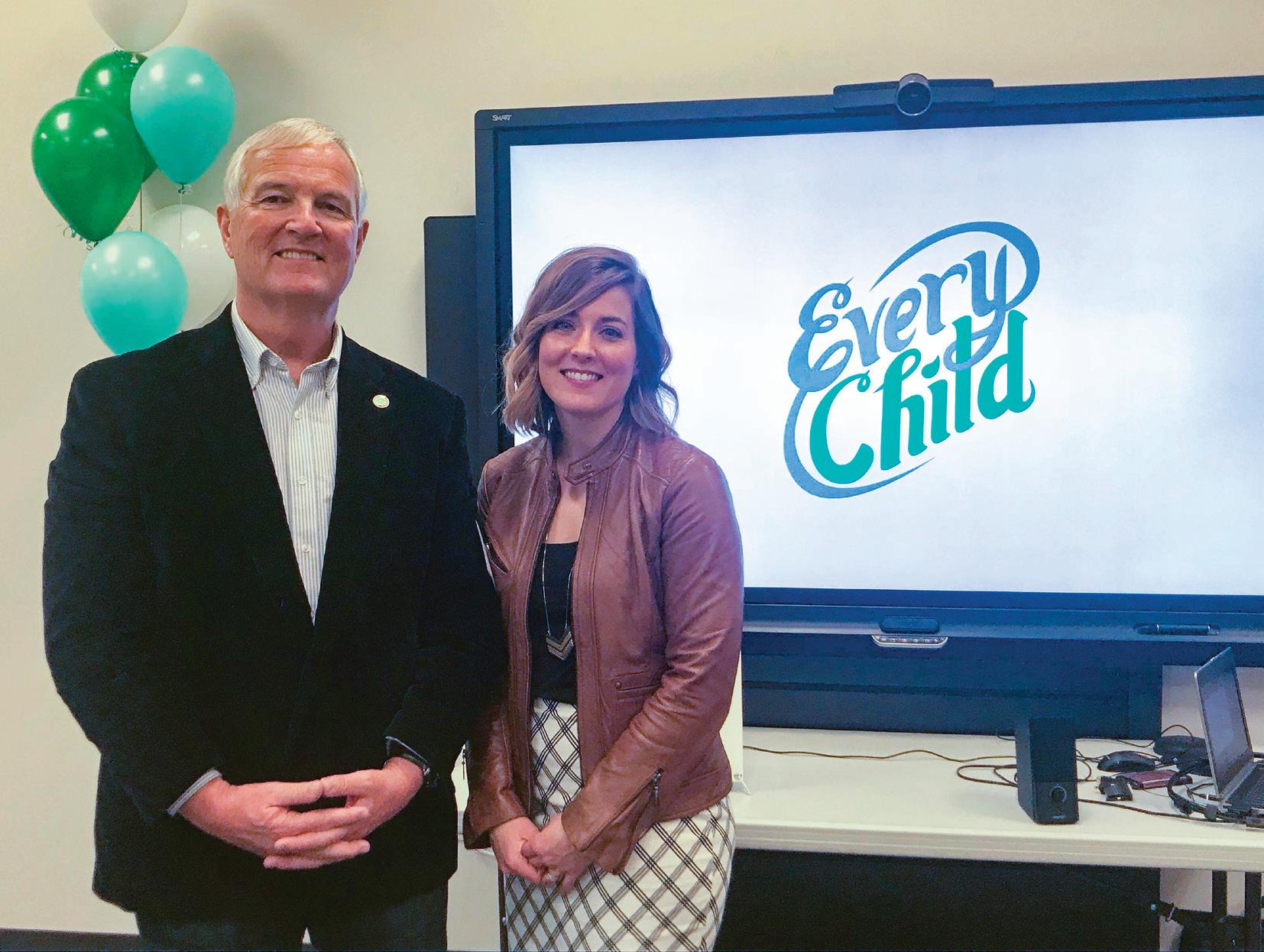
“I don’t see myself being a foster parent because I’m already working with some of the neediest kids, many in foster care,” she says. “I’m excited that I can help through this organization wrapping around the communities that serve foster kids and families. The whole point is to make the foster care experience better for them.”
Three days a week, trained volunteers with My NeighbOR manage specific drop-off areas, which they keep sanitized. If donors or families cannot make it to the anchor sites, My NeighbOR calls on local drivers from Team Rubicon—an international nongovernment organization of volunteer military veterans and first responders who serve vulnerable populations impacted by disaster.
My NeighbOR follows up to make sure families received everything.
It was a My NeighbOR donor who gave a bike to the 6-year-old girl.
“She wanted one of her own that she could take home with her,” says her foster mother, who also received a car seat and gift cards for the girl, as well as the duplicate books she video-reads with her mother. “It’s amazing to see the outpouring from the community. She’s learning to trust that she and her mother are loved. And because things are given to her, she’s also learning that she can give things to others.”
Donors also benefit.
“They have a chance to help write her story and create her treasured memories of foster care,” the foster mother says. n
For more about My NeighbOR and to volunteer, donate and/or receive donations, go to https://everychildoregon.org/myneighbor.
ABOUT THE SERIES: Pioneer, publisher of Ruralite and Currents magazines, spotlights Heroes Among Us, sharing the unique stories of volunteers and difference-makers in communities across the Northwest and West. The yearlong series receives support from the M.J. Murdock Charitable Trust—a private, nonprofit foundation serving nonprofits across the Pacific Northwest. The Murdock Trust supports organizations such as Embrace Oregon and The Contingent, which serve foster children and their families in communities throughout Oregon and the Pacific Northwest.
By Lori Russell
Flip it on. Plug it in. Power it up. Reliable electricity runs our lights, charges our phones, and powers our homes and water heaters.
Most of the time, we don’t give it a second thought. Less than 100 years ago, it was a different story.
While nearly 90% of Americans living in cities had access to electricity by the 1930s, it was still unavailable on most farms, ranches and other rural areas.
The Rural Electrification Act of 1936—part of President Franklin Roosevelt’s New Deal—provided federal loans to install systems to bring electricity to isolated rural areas of the U.S. Most of the funds were used by member-owned electric cooperatives that sprang up to create their own electricity distribution lines.
REA crews traveled around the country connecting the networks, bringing crews of electricians to wire houses and barns. Even so, it was years— sometimes decades—before remote areas of the country
had electricity 24 hours a day, seven days a week.
Three eyewitnesses share what life was like before and after the lights came on.
Their stories are part of a vanishing generation.
The Summer Everything Changed
Growing up in northern Bonner County, Idaho, in the 1940s and ’50s, Kari Clark lived with her parents and seven siblings in a two-story log house that her father built.
No one in their tiny rural community had a phone or electricity. The Clarks lit their home with kerosene lamps and heated it with a wood stove.
“It seemed like the normal thing,” says the 79-year-old who now lives in Sutherlin, Oregon. “We were used to it because everyone had them. We were like any kids who caroused, but we knew better than to do that in the house because of the kerosene lamps.”
By 1950, many city kids enjoyed watching “The Lone Ranger” and “Howdy Doody” on black-and-white TVs. Kari and her siblings studied in a










one-room schoolhouse lit with a gas lamp in each corner.
“It all seemed very modern until you went into the city,” Kari says. “We’d go once or twice in the winter and see all the lights.”
The streetlights, neon signs and Christmas tree lights in Sandpoint, Idaho—about 20 miles from the Clark home— fascinated the young girl.
“We knew, of course, what we had wasn’t like what

everyone else had,” she says. “We thought it was amazing.”
In the summer of 1951, everything changed in northern Bonner County.
Kari wrote about the experience in her story, “Electricity in Pack River Valley,” that she shared with Ruralite:
“In came a whole bunch of trucks and workers for the REA; there was talk we would actually get electric lights by fall. When a worker was climbing up a pole by the side of our kitchen garden—our pole for just us— Mom even took a picture of him with her Brownie (camera). By the end of the summer, Dad, with a little wiring instruction, had our house ready. By late fall, in almost every room there was a lightbulb on the ceiling and a string hanging from it to turn it on. We kids got in the habit of
putting on rubber boots before ever pulling that string until Dad said it wasn’t necessary.”
Like many REA homes after World War II, the Clarks’ house was fitted with a ceilingmounted lightbulb in each room and circuits for a range and refrigerator in the kitchen. Because appliances were still expensive and uncommon at the time, only one electrical outlet was installed in each room.
While the new power supply brought some immediate changes for the Clarks, others took place over time. The family continued to use a wood stove to cook and heat the house. A refrigerator and a stove didn’t seem like a necessity, Kari says. Items that needed to be kept cold were stored outside. In the summer, they kept a container of milk

cold in the creek.
“We didn’t have the money to go out and buy a lot of stuff, but gradually my siblings left home to go to high school,” she says.
“My older sisters would give my parents a percolator, a toaster or an electric clock.”
Her parents bought their first electric range nearly a decade after their first lightbulb.
“Electricity was one of the most important things in my entire life,” says Kari, “even more than when I first saw television.”
From With to Without In 1943, 25-year-old Mildred
Craber moved with her husband, Harold, and young daughter to Moro County, Oregon, to live with her in-laws.
Their home—22 miles outside of Heppner—had no running water, indoor plumbing or electricity. Living in those conditions after having been raised in The Dalles 130 miles to the west—with all the modern amenities—was a challenge, Mildred said. She likened it to camping out, only worse, since she was pregnant and also had a toddler to chase after.
Mildred, 102 years old at the time she was interviewed for this story, recalled the cold mornings she loaded and lit the two wood stoves: one for heating the house and another for cooking. Water hauled from the nearby creek by her husband was warmed on the stove for washing dishes, laundry and family members.
Daughter Donnamae Grannemann was not quite 2 years old when the family made the move to Moro County.
“I remembered to stay close to Mommy,” she says. “I knew not to get near the wood stove because I could get burned, and to keep my toys away from there because it could cause a fire.”
Mildred would fix a big pot of beans or stew in the morning and let it cook on the stove until supper. Leftovers were few, but those that needed saving were kept cool in a small oak ice box, along with milk and eggs. A new block of ice was delivered every few days.
“In the evenings, I had to get things ready so we had lights before it got dark and get things ready for supper,” Mildred said.
She cleaned and filled the kerosene lamps each day and sewed clothes for her family on a treadle machine.
“I can’t imagine if you had a job with all that, too,” Donnamae says. “You couldn’t come home and take a shower with running water. You had to get that galvanized tub out. Everyone took a bath in the kitchen with water heated on the stove.”
While essential, kerosene lamps were also dangerous.
“We had company for supper, and I went in the kitchen and the flames were coming up the wall,” Mildred
said. “We got the fire out right quick, but it scared me to death. It was something I hadn’t learned to watch. I learned to watch it after that.”
Mildred was relieved to move back to The Dalles area with her family a few months after her second child was born.
“I didn’t have to fill the lamps,” she said. “I could cook so much easier. I had a refrigerator. And no more chamber pots.”
Mildred died earlier this year after sharing what life was like without electricity. Her family is grateful her memories were captured.
The Power to Connect Holly Bell was born and raised in Hooper Bay, Alaska, more than 500 miles from Anchorage on the Bering Sea coast.
As a young boy in the 1960s, 9 p.m. was lights out for him and his seven siblings. Literally. That’s when the electricity shut off in the family’s one-room camp house.
“Every night, the light would get dim,” Holly says. “My parents would say, ‘Oh, that’s Walter Naneng’s eyes looking for you. You better go to bed before the light goes off.’”
Walter Naneng operated the village’s tiny power plant that was housed in a 5-foot-by-5foot shed.
Holly remembers winter temperatures as low as 80 degrees below zero when he was a boy. Each day at 7 a.m., he rolled out of bed and felt the icy chill as his bare feet hit the floor. Wrapped in his father’s parka, he lit the driftwood and coal in the wood stove, set his father’s coffee and his mother’s tea water to heat, and poured sourdough batter on the

griddle—enough for six pancakes at a time.
“I loved it,” he says.
Not every building in Hooper Bay had access to the village power supply. The school and store ran on their own generators. Some residents used a wind generator with wooden propellers mounted on their roofs or on poles to generate electricity. Holly says those units could be dangerous because the props sometimes flew off in high winds. He saw one cut into a house.
In 1968, Hooper Bay became one of the first Alaskan villages electrified by Alaska Village Electric Cooperative. The project brought electric service to all the houses and churches, the mission house, store and elementary school.
Holly, then 8 years old, was
one of more than 150 people who witnessed lighting of the first community Christmas tree—and the entire village—on December 16, 1968. His father, dressed as Santa, passed out presents to the crowd under the tree’s twinkling lights.
With the addition of round-the-clock electricity in Hooper Bay, the local store began selling more appliances. While some families bought refrigerators and freezers, the Bell family didn’t have room for either in their home. Their first purchase was a toaster.
“A lot of people were glad electricity was coming and that their houses were connected,” says Holly, who still lives in Hooper Bay. “One person can’t live out here alone. People help each other a lot. Everybody needs help.” n

What did Grandma’s childhood kitchen look like? Why did Uncle Rick move across the country after the war? What was life like before cellphones and computers?
Here are some tips for collecting and recording oral histories and family folklore for future generations.
• Often the best interviews happen naturally during family dinners or reunions where storytelling occurs. Anticipate these opportunities and go prepared.
• If you don’t want to wait until the next family event, create one. Invite relatives who interact well together. One story—and one interpretation—leads to another.
• A one-on-one interview with a
relative in familiar, relaxed surroundings may result in different stories or more personal details than those told in a group.
• Create a list of three to five topics you want to cover in your interview, such as family heritage, childhood, raising children, work, school or military service. It is helpful to have a list of open-ended questions, but don’t be afraid to let your subject go off on a tangent. Interesting stories can emerge. Story Corps offers sample questions at storycorps.org/ participate/great-questions.
• Tape-Record conversations. This is easier than taking notes or relying on your memory. Most mobile devices can do both audio and video recordings. Ask your subject’s permission before recording, run
a test to make sure all the voices can be heard, then set it and forget it.
• Use photos, letters, scrapbooks or other heirlooms to help spark memories.
• During conversations, listen for the names of other family members or nonrelatives you can also interview. Or ask directly, “Can you tell me who might know more about that?”
• Schedule your visit at a convenient time for your subject and end the interview when they start to become fatigued. You can always return for another conversation.
The Smithsonian Museum offers more detailed information for collecting family folklore at smithsonianeducation.org/migrations/seek2/ begin.html.



Carrot Beet Hummus
½ small beet, roasted until tender
1 small carrot, roasted
1 clove garlic, roasted and minced
7 ounces chickpeas, well-cooked or canned
½ large lemon, juiced

1½ tablespoons tahini
Pinch of salt
Pinch of black pepper ¼ cup olive oil
Cool the roasted ingredients and put them in a food processor. Blend until smooth. Add the chickpeas, lemon juice, tahini, salt and pepper. Continue processing. Add the olive oil while stirring gently. Add more olive oil to reach desired consistency.
Serves 2

3 large ripe Hass avocados
3 tablespoons olive oil
4 tablespoons heavy cream
Juice of one lime
¼ cup cilantro, finely chopped
½ red bell pepper, diced
1 tablespoon roasted or fresh poblano pepper, minced
½ small Roma tomato, diced
1 clove of garlic, crushed and minced
1 small green onion, finely sliced
½ teaspoon cumin
¼ to ½ teaspoon salt
Dash of black pepper
Dash of cayenne or paprika
4 heads of Belgian endives, leaves separated
Slice, pit and peel the avocados. Using a fork, mash the avocados with the oil and heavy cream until smooth. Add the remaining ingredients, except for the endives. Mix thoroughly.
Serve with endive leaves as chips or scoops. Squeeze additional lime juice on top of the guacamole to ensure freshness and keep it from browning.
Serves 2
Recipe by Chelsea Glanz
½ medium sweet potato, peeled and grated
1 large carrot, grated
½ cup flax seeds
1 egg white
Heat oven to 375 F.
4 tablespoons lukewarm water
1⁄3 cup hulled pumpkin seeds
¼ cup hemp seeds
2 tablespoons olive oil
Stir all ingredients together in a large mixing bowl, mashing with hands until well combined and slightly sticky. The batter will be crumbly but should stick together when squished into a small ball. If not sticky enough, add additional flax seed and water by the tablespoonful, which together act as a binding agent.
Pat the mixture onto large, greased baking sheets, and flatten the mixture into an even spread. The batter should be tightly packed, no more than ¼-inch thick. The pan should not show through.
Bake for about 10 minutes, checking occasionally, until slightly crusted and firm. Remove from heat and slice into square crackers with a pizza cutter. Slide a spatula under the crackers, gently releasing any that may have stuck to the pan. Bake for another 2 to 5 minutes until crispy.
Serves 2
Recipe by Chelsea Glanz
¼ cup carrot juice
¼ cup orange juice
2 tablespoons pomegranate juice
1 banana, blended
1 tablespoon lemon juice
½ cup apricot nectar
Combine all ingredients and divide among four popsicle holders with sticks. Freeze for at least an hour.
Juice types can vary. Try tropical flavors such as pineapple juice and a dab of hydrating coconut water. For a thicker, creamier popsicle, blend bananas with frozen strawberries or blueberries, pour into the popsicle holders and freeze. Once frozen, creamier popsicles can be dipped into chocolate sauce.
Serves 4
Recipe by Chelsea Glanz
4 large tortillas, sliced into chip-size wedges
2 large heirloom tomatoes, finely chopped
1 green onion, bulb and stem, finely chopped
1 red onion, finely chopped
¼ bunch fresh cilantro, minced
Heat oven to 350 F.
1 clove garlic, crushed or minced
1 medium hot chile pepper, diced (Anaheim or poblano work well)
Juice of one lime
Salt and pepper, to taste
Lay tortilla slices out on one or two large cookie sheets, one layer thick. Bake for about 2 minutes, until wedges are golden and stiff. Remove from heat. Mix all salsa ingredients thoroughly. Let flavors blend for at least 30 minutes before serving with chips.
Serves 2
Recipe by Chelsea Glanz
½ cup tahini
¼ cup creamy peanut butter
Juice of 1 lemon
2 tablespoons soy sauce or tamari
½ clove garlic, minced
Salt and pepper, to taste
Dash of red pepper flakes
¼ cup olive oil
6 large hakurei turnips, washed and sliced
Place all ingredients except turnips and oil in a food processor or high-powered blender. Process until smooth. Add the oil slowly while processing until desired consistency. If the mixture is still too thick, add water slowly by the tablespoonful. The final sauce should be creamy and thick. Serve with turnip slices.
Serves 2
Recipe by Chelsea Glanz
I am in need of Regular Baptist Press Sunday School teachers’ packets for 2’s and 3’s. They must be from the 1990s or early 2000s. I will pay a resonable amount and reimburse shipping costs. Thank you.
Juanna Beth Lewis
268 Iron Horse Lane Challis, ID 83226
I am reaching out to see if anyone is in need of greeting card fronts for craft projects. Please contact me if you are interested.
Kathy Heitkemper
1302 Hermits Way The Dalles, OR 97058
I am looking for 100% cotton yarn for dishcloths; any amount would be greatly appreciated. Thanks.
Anisa Troyer
35711 Kennel Road SE Albany, OR 97322
I’m trying to research the history of Pennington Lumber Mill and the surrounding area on Penn Road. It is located roughly 3 miles east of Walton, Oregon, south of Highway 126. I am seeking photos and documents relevant to the mill, the mill community and other structures. If you have relatives who worked there and may have materials, please reach out.
M. Denmark
P.O. Box 336 Noti, OR 97461
I am giving away 160 doll patterns. I have used patterns and items in new packaging from several companies. There are various clothes, patterns and sizes. I have clothing patterns for both girl and boy dolls, underwear, hats and shoes. I can deliver to Redmond, Bend, Sunriver and La Pine areas. Outside areas must pay postage. Patterns are still free. Please email if interested.
Laurel Crover
20900 SE Lansing Lane Damascus, OR 97089 DollsLCC@comcast.net
My mother will be 90 on July 12. I would like to surprise her with birthday wishes from readers. She will be so delighted and it will make her birthday a wonderful day. AMD has diminished her eyesight, so I will read any messages sent to her. Please send cards to Mayanna Kopp, P.O. Box N, Pilot Rock, OR 97868. Thank you so much.
Ron Kopp Condon, Oregon
My mother-in-law, Marilyn Hummel, celebrates her 80th birthday July 5. She would be tickled to receive birthday greetings from all of you. Please send cards to: 4808 Desert Plateau Drive, Pasco, WA 99301. Thank you so very much.
Julie Hummel Pasco, Washington
I am the quality of life coordinator at The Cottages of Boise assisted living. One of my residents, MayBelle Wendler, is going
Please send your request —with no attachments—to readerexchange@ruralite.org or mail to to Reader Exchange, 5625 NE Elam Young Parkway, Ste. 100, Hillsboro, OR 97124. Please fill in the subject line with Reader Exchange. Acceptance, scheduling and editing are at the editor’s discretion. Single requests only, please. No duplicates. Submissions are handled on a first-come basis. Phone numbers will not be published. Email addresses will be published if part of the ad, but the request must include a postal address. Request must include the name, address and name of the electric utility that provides your magazine.
to be 109 years old on July 20. MayBelle would love cards sent to her for her special day. Her address is: MayBelle Wendler, c/o The Cottages of Boise, 6300 N. Roe St., Boise, ID 83714
Karena Whitmer Boise, Idaho
My mom will be 90 in July. Mom is in assisted living, helpful, still misses being a pastor’s wife and hosting get-togethers with members of the congregation. She would be so excited and blessed to receive birthday cards from as many people as possible. She’s always disappointed when her mailbox is empty. Please send the cards to: Bette Metzgar, Awbrey Place, 2825 Neff Road, Bend OR, 97701. Thank you so much for making Mom feel special.
Suzie Peterson Redmond, Oregon
My mother-in-law, June Vroman, loves to send and receive cards. She has been a widow for more than 30 years and just turned 90 years old. Nothing stops her from sending cards. She even sends each of her remaining children, grandchildren and great-grandchildren $5 for their birthdays. June is a great mom-in-law, not just because she even sent me $5 for a birthday a time or two. Anyone who might wish to, please send a card to: June Vroman, P.O. Box 31, Shoshoni, WY 82649
Dee R. Lundbeck
North Pole, Alaska
I want to thank the many gererous folks who gave me a very special 90th birthday. Due to my daughter Sheri’s request, I have received 450 cards and 40 books. The books included some of my favorite authors and titles. Several folks told a bit of their lives. It was great fun to read all correspondence in midst the coronovirus quarantine. Many, many thanks.
Gerald Hagquist
West Berlin, New Jersey






You can’t always lie down in bed and sleep. Heartburn, cardiac problems, hip or back aches – and dozens of other ailments and worries. Those are the nights you’d give anything for a comfortable chair to sleep in: one that reclines to exactly the right degree, raises your feet and legs just where you want them, supports your head and shoulders properly, and operates at the touch of a button.
Our Perfect Sleep Chair® does all that end more. More than a chair or recliner, it’s designed to provide total comfort. Choose your preferred heat and massage settings, for hours of soothing relaxation. Reading or watching TV? Our chair’s recline technology allows you to pause the chair in an infinite number of settings. And best of all, it features a powerful lift mechanism that tilts the entire chair forward, making it easy to stand. You’ll love the other benefits, too. It helps

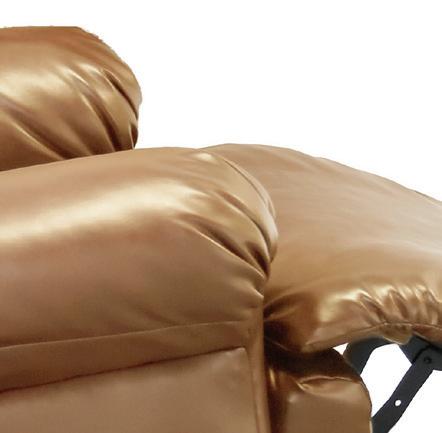




with correct spinal alignment and promotes back pressure relief, to prevent back and muscle pain. The overstuffed, oversized biscuit style back and unique seat design will cradle you in comfort. Generously filled, wide armrests provide enhanced arm support when sitting or reclining. It even has a battery backup in case of a power outage.
White glove delivery included in shipping charge. Professionals will deliver the chair to the exact spot in your home where you want it, unpack it, inspect it, test it, position it, and even carry the packaging away! You get your choice of stain and water repellent custom-manufactured Duralux with the classic leather look or plush microfiber in a variety of colors to fit any decor. Call now!











When driving through Arizona on a summer road trip, take a detour along Highway 45 to cross over Lake Havasu City’s London Bridge.
Industrialist Robert P. McCulloch founded Lake Havasu City in 1964. He bought the London Bridge at auction for $2.46 million, thinking it would bring interest to the area. He spent another $7 million transporting, rebuilding and reinforcing it. The bridge was dedicated in 1971.
The 930-foot London Bridge straddled the Thames from 1832 to 1968. Under the weight of modern traffic, the bridge was sinking into the river. The London Bridge was falling down slightly more than an inch every eight years.
On your road trip, you can also visit the 320-foot-tall Parker Dam on the ArizonaCalifornia border. Construction on the dam began in 1934. Lake Havasu is its reservoir. Parker Dam is the world’s deepest dam, with 73% of the dam’s height beneath the water.
This London Bridge is lined with vintage iron lamps. The iron was once in Napoleon’s army. Cannons confiscated after the Battle of Waterloo were melted down to make the lamps.
To learn more about the bridge, as well as more things to do in Lake Havasu City, visit GoLakeHavasu. com or call 928-453-3444.
















IF I AM LUCKY, I make a dozen pictures a year that I like. This quiet moment is one of my favorites from 2019. While attending a small family memorial for my father, who died the year before, and after spreading his ashes on a small mountain of rocks topped with an old cross, I followed my aunts, Betty and Alice—both in their 80s—as they shuffled to the house. The tilt of their bodies and the supporting hand from Betty on her older sister’s back says more about losing their oldest brother and how they, too, are nearing the end of their life journeys than any of the images I made of the ceremony or group photos afterward. In a real sense, this picture represents my photo signature: a quiet, subtle storytelling image of comfort and compassion. I have found the best stories are often in the shadows of life, away from big events and spotlights. For me, the smallest, often unnoticed gestures speak the most about the human experience. This is one time it helped to be taller than my photo subjects, which allowed me to somewhat clean up the background and avoid bad compositional mergers. I shoot more pictures from my knees or below than standing upright, and have always felt shorter photographers have an advantage, especially when it comes to getting low to clean up backgrounds.
See if you can make a candid image where touch helps tell the story. Watch body language closely to anticipate where important and storytelling touch will happen. To respond to this challenge and share your work, email your best image to social@pur.coop with a caption and photo credit. We will share the best submissions on our website or social media channels.
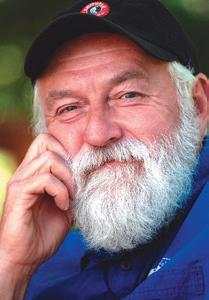
Dave LaBelle spent his boyhood years taking photos and began his storied photojournalism career while still in high school. He has worked for 20 newspapers and magazines in nine states, and taught at three universities. The internationally known photographer, author and lecturer has shared his photo tips and life perspectives here since 2009. For more information, visit www.greatpicturehunt.com. To read more of Dave’s writings on life, visit bridgesandangels.wordpress.com.


















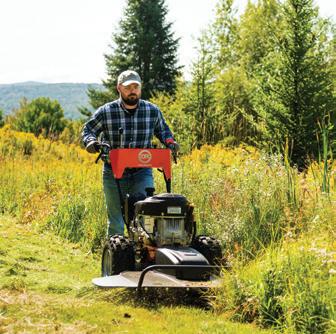




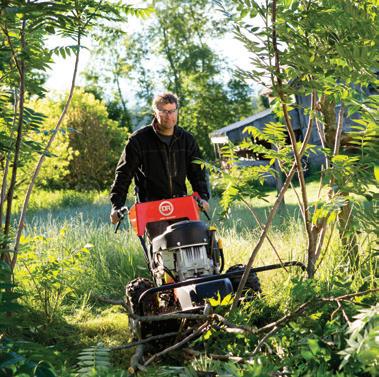






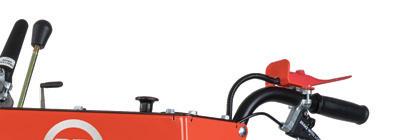









It is time to share your most winning photos for a chance to appear in our 2021 Ruralite calendar.
Up to 13 winners will be selected, each receiving $100. Photos must be submitted by July 17, 2020. The contest is open to recipients of Ruralite and Currents magazines.
Each person may submit two photos. Each photo submission must include:
• Photographer’s name, address and electric utility.
• A short description of what is shown.
• Photographer’s email address and phone number.
• Digital JPEG photos only. Photos must be horizontal or landscape format
and at least 300 dpi at 11 inches wide by 9 inches tall. Vertical photos and files larger than 20 megabytes will not be accepted. Send submissions to calendar@ruralite.org. Put “2021 Calendar Photo Contest” in the subject line.
• Use highest resolution setting on your digital camera.

• Photograph beautiful places and wildlife. Capture scenes full of vivid color. Reflect the seasons.
Focus on the beauty of Ruralite and Currents geography. Make us feel something (awe, laughter).
As a not-for-profit membership cooperative, Mohave Electric is owned by the members it serves.
A $5 membership fee is paid when signing up for new service—a fee that has remained unchanged since MEC was born in 1946.
Members participate in the cooperative business by electing a board of directors to represent them. The directors, also members, set policies and make decisions.
There are no shareholders.
The original MEC Board of Directors borrowed funds from the U.S. Department of Agriculture to begin providing electric service to the first members.
Because MEC borrows from the government and other lenders, it must meet each lender’s requirements by operating to recover annual margins 10% more than the cost of interest on borrowed funds.
MEC operates as a not-forprofit corporation. Revenues from the sale of electricity are used to buy wholesale power, pay operating expenses, make payments on outstanding loans and provide a financial reserve as a condition of lenders. Any remaining funds are called margins.
Every year, margins are
allocated to MEC members as capital credits.
MEC may refund (retire) some or all of those margins or retain the margins to help build more system infrastructure in lieu of borrowing money.
The board of directors can authorize to retire (pay out) part or all of the capital credits for a certain year or years.
Once the board of directors authorizes paying out capital credits for a certain year or years, a member has essentially been paid back the excess money they paid for electricity, as directed by the government to satisfy debt requirements and according to the MEC bylaws.
All cooperative members
thus are buying their electric service at cost. This is the most beneficial advantage to being a member of MEC.
For the last six years, the MEC Board of Directors has elected to retire capital credits because doing so would not harm the cooperative financially.
Such will be the case in 2020. In June, members received their portion of this year’s retirement as a bill credit, if less than $10, or a check if their retirement share is more than $10.
The MEC Board of Directors elected to retire all of the capital credits due members from 1988 and 2019.
“We made an important decision to retire as much as we could afford to this year, as we try to help our members cope with the COVID-19 financial impacts,” MEC CEO Tyler Carlson says.
Since 2015, MEC has returned $8.5 million in capital credits to members.
This entire process is the pinnacle of the many advantages of being served by a cooperative. Members ultimately pay cost for the power they purchase from the electric cooperative, which is governed by local people who are cooperative members. n
Agriculture
Reinforced custom-sized pond liners (39 cents/sqft). Hay covers, greenhouse covers, any width & length. Truck tarps & more. High puncture & tear strength. Best price guaranteed. American made since 1981. www.btlliners.com; 541-447-0712. 0421
Automotive
1989 Chrysler TC by Maserati. 2.2 turbo automatic. Red w/ginger soft top & interior, nice hard top, 158,000mi. All records. Garaged since 2008, all newsletters & service manuals. $5,250 OBO. rcsheldrake@gmail.com. 541-760-3024 0720
Books, Magazines, Videos
“Snowbound Stagecoach,” fact-based account of 1862 blizzard in Oregon, Washington, Idaho. By Lenora Whiteman, Moonglade Press. Gold miners, pioneers, hardship, bravery. Available from Amazon. 0720
Building Supplies
Solar thermal panels, storage tanks, Hydronic baseboard radiators, boilers, misc equipment for sale. Good condition used parts. Great opportunity for the DIY handyman. Prices reasonable & negotiable. Cash sales only. Steve, 541-948-2295; steve@bendheating.com.
Business Opportunities
Starbuck, Washington, near Dayton. Store/ pub 2,400sqft metal building constructed 2008. Clean, thousands in equipment. Presently operational. Near new straw plant. Live/work here. $199,950. Also, 4 buildable lots, w/ service, Starbuck. All $99,500. 253-261-5340, 253-302-0853. 0920
Income-producing property in Superior, Montana. Rare opportunity to own muchloved historic Superior County High School, listed on the National Register of Historic Places offering amazing mixed-use potential.
Currently partially leased w/professional office/retail. 26,555sqft. building. 1.51ac land. $695,000. MLS #21912651. Kathi Olson, BHHS Montana Properties, 406-544-7359; Kathi.Olson@BHHSMT.com. 0720
Equipment/Tools
CubCadetTractor50”mowerdeck.Brand new,neverused,locatedinPahrump,Nevada. $350.775-764-8076. 0720
Farm Equipment
Antique farm machinery. 2 plows, disc, farm wagon, front & wheels, 1920 tractor, 36” grinding wheel. 200 old bottles. 775-318-0049; Aaron.buffington@yahoo.com. 0720
1959 Massey Ferguson tractor has had total restoration. Rear 3-point hitch. Motor & tran have complete rebuild. 4 new tires. $5,250 OBO. Clatskanie, Oregon. Jon, 503-728-3562.
Help Wanted
Mitchell (Oregon) School is looking for a dormitory parent to manage our co-ed international dorm in the 2020-2021 school year. Searching for a dynamic person or couple who would love the challenge of supervising 10-20 students during the school year. It is a great way to have a positive impact in the lives of high school students. Contact Valerie Swagerty, 541-462-3311, or go to www.mitchell.k12.or.us & click on employment for more information or to apply. Hobbies, Gifts, Games
Selling fly-tying room. Vises, Dyna King, Regal #1, #2 hackles, tools, feathers, dubing, hair, thread, hooks, books, videos. Specialized items. Photos available. 541-523-2814. 0720
Home and Hearth
I invented a mailbox accessory that keeps mail up front and within reach: the “Let’R Stop.”
Only $11.99, plus S&H. Buy yours today. www.letrstop.com. 0820
Ads 25 words or fewer are $35 a month. An extended ad of up to 35 words is $50 a month. Contact information is included in the word count.
Longer ads may be placed. For pricing, contact 503-718-3717 or lwiseman@pur.coop.
Ads are for customers of member co-ops, PUDs and municipals only. Subscribers and nonmembers may inquire for pricing at 503-718-3717 or lwiseman@pur.coop.
Ads must be direct and in first person, and are subject to approval and editing.
Closing deadlines (in our office): September issue— July 31, 2020.
Local Pahrump, Nevada, commercial fisherman sells sashimi-grade gourmet canned tuna on internet: 100% guaranteed to be the best canned tuna you ever tasted. Twofisherstuna.com. 206-799-1082. 0820
Cemetery markers, both granite & bronze. Also offering bronze plaques, signage. All at affordable prices. Shipping available. Call Joe Plass for more info, 541-815-8906; www.highdesertmemorials.com. 0820
Beautiful little zebra finches. Add a cheerful note to your home. 1@$15. 2@$25. dixieearle@yahoo.com. 541-910-1324. 0720
100% natural/holistic dog, cat, & horse treats. Made in the U.S.A. Allergy free. Missy.petclub247.com. Call Heather Jensen, 208-420-4146. 0820
Looking for toy or teacup poodle for stud service in Oregon, Washington or northern California. Linda, 541-981-0337.
AKC-registered Airedales. Fort Sage Kennels, Patricia Sharp, P.O. Box 246, Doyle, CA 96109; 530-827-2271. 0321
70’x42’ inflatable swimming pool enclosure with heaters/blowers. $21,000 new; used one winter. $7,500 or make an offer. Freight extra. Pictures, additional information available. 775-727-4414; manager@preferredrv.com. 0920
Valley views, end-of-road privacy, 1,404sf, likenew manufactured home, fenced 95ac dryland pasture, turnkey, Cedarville, California. $309,500. Janie Erkiaga Broker, #01033704. 530-233-4128. 0720
If submitting ad by mail, send appropriate payment with your name, address, email, phone number and the name of the electric utility that provides your magazine to: Marketplace, 5625 NE Elam Young Pkwy Ste 100, Hillsboro, OR 97124. Make check or money order payable to Ruralite.
We accept credit card payments for ads submitted by email. Send ad to lwiseman@pur.coop.
High desert hideaway, old 40ac Idaho horse farm, secluded, accessible, unique. 2bdr log home, large barn, log bunkhouse. Good well & fence. $158K. 208-589-9042. 0720
Kanab, Utah, home of Western Legends Festival, 10mi up beautiful Johnson Canyon, 20.39ac, 8” waterlines w/flow valves, 10AF water, more avail. Great ret/vac location w/ in 1hr drive of Bryce Canyon, Zion National Park, Lake Powell, north rim of Grand Canyon. $321,777, OWC. 775-253-0531. Google Earth 37 10’02.85N X 112 23’16.05W
56ac in Southeast Nevada, next to Grant Wilderness. Remote w/access & spring. Hunt, hike, prospect. 775-318-0049; Aaron.buffington@yahoo.com. 0720
Let me help you buy or sell ranch, farm & recreation property in Oregon. Fourthgeneration Oregonian, ranch owner. 240ac for sale in Bend, $1,499,000. John Gill, 541-4809161; johngill@landandwildlife.com. Land And Wildlife brokerage.
Sportsman’s paradise, prepper’s hideaway. 1,300+sqft, 2bdr, 1ba on 4.9ac, ½mi from Alyeska Pipeline, on road system in Alaska game management, unit 13D. Copper River Basin. Contact: winter 480-247-6348; summer 907-822-5139. 0920
Buildable, 4.26ac, gated community above Ochoco Reservoir, Prineville, Oregon. Spectacular views. 400-amp service; shared well w/cistern ready. RV parking, if shielded. Septic approved. $134,000. 503-622-6515. 0720
Looking to relocate in western Montana? Commercial, residential, land, investment. Contact Kathi Olson, BHHS Montana Properties, 406-544-7359. 0720
Dubois, Wyoming. Union Pass. 2 adjoining parcels. 3.89ac $108,920. Mostly cleared 3.16ac $88,480. Power, phone, high-speed internet at road. Amazing wooded view lots
of the Absaroka Mountains & Dunoir Valley. Rockysamson45@gmail.com. Serious inquiries only. 0720
Premiere Oregon Properties: 30yrs experience getting the best price for sellers and buyers. 4 sale: Old Mill Farm Store in business since 1853. $935k. 4 sale: 225ac 2.5mi Umpqua River frontage. Possible wetland mitigation property. $700k. 541-480-0212. James Wardrope Realty. OregonRiverRealty.com; office@RiverInnElkton.com. 0720
100ac timbered property, bordered by government lands. 2bdr, 2ba 1,200sqft 2012 manufactured home w/snow roof. 36’x48’ insulated shop w/20’ overhang, recreation room, full bathroom. Cascade Mountains views. Backup generator. Deer & elk out back door. 30mi north of Chiloquin, Oregon. Access from paved road. $589,000. Call 541-891-0385. 0720
Recreational Rentals
Bleached & ready when rentals re-allowed. Wavecatcher: Oceanfront, central Oregon Coast. Easy beach access. $145/night summer, $110/night winter; seventh night free. Two bedrooms w/double beds, sleeping loft w/ double beds. Full kitchen/bath, linens. Pet friendly. Check wavecatcherbeachrentals.com for availability. 541-740-9953. 0720AR
Bend country cabin. Very clean & fully furnished cabin on private ranch. Close to recreation areas. Very nice. $90/night. 541382-3050; bendcountrycabins@gmail.com. 0720
Stay one night or a week. Bed-and-breakfast outside of Orofino, Idaho, near Dworshak Reservoir. Hiking trails, fishing, boating & more. Visit www.thehighcountryinn.com. 0720
Oceanside, Oregon. Romantic 3bdr retreat for special occasions. Newly remodeled. 5min walk to beach, 2 lg decks facing ocean. 503649-9463; www.dreamvacationspots.com. 1120
Plan your summer vacation now. Vista House Vacation Rental in quaint hillside village of Oceanside, Oregon. Unobstructed ocean views from all 3 units. Slps 2-16. Everything you need for unforgettable vacation. Owner operated. Very clean. 503-730-7149; vistahouseoceanside.com. 0720
Lincoln City, Oregon. Beautiful ocean views. Slps 12. 4bdr (2 w/king), 3 full baths, Wi-Fi, cable, frplc, W/D, dishwasher, 2nd kitchen upstairs. Info/pics: VRBO.com/693193. Call for special prices. fbeckwithfamily@gmail.com; 503-720-6144. 0920
Old carpenter tools, planes (wood/metal), levels, chisels, slicks, adzes, axes, hatchets, handsaws, old rulers, spoke shaves, wrenches, shipwright tools, old tool chests. 503-659-0009. 0720
Buy, sell, repair rock saws and everything lapidary. Buying old rock and gem books & catalogs. CigarBoxRock.com. 541-280-5574; cbr@bendnet.com. Bend, Oregon 97701. 0820
Collecting old cowboy & Indian art & artifacts, Navajo jewelry, rugs, baskets, beadwork. Want signed old paintings of the Southwest & early Eastern paintings & sculpture. Classic cars or trucks, collections or individual pieces. 760409-3117; amer.ind.baskets@gmail.com. 0720
Gold, silver, coins/currency, buy, sell. Collections wanted. Fair prices paid. 40yrs in retail store. Baker City, Oregon. 800-556-2133; garrymclin@aol.com. Will travel. 1020
Wanted. Vintage pocket watches, watch collections, wristwatches, watchmakers’ estates, etc. Call 541-760-1050. Please leave a message if I don’t answer. Will travel. Thank you. 0820
Motorcycles. Pre-1980 road bikes only. No restored bikes, HDs, cruisers. Any condition. Hobbyist. Not a shop. ten1pdx@yahoo.com. 503-260-5597; 0820
Bean Picnic Salad, Sweet and Sour Red Cabbage Salad, Cucumber Salad with Spicy Dressing—these recipes and many more are available in this booklet of reader recipes. With more than 200 recipes, this cookbook features fruit salads, vegetable salads, pasta salads, meat salads and more. The cookbook is 8½x11-inch spiral-bound, indexed and only $6 (includes postage).
To order by mail, submit with proper payment, cookbook title, name, address and number of cookbooks wanted to Ruralite Cookbooks, 5625 NE Elam Young Pkwy, Ste. 100, Hillsboro, OR 97124.
To pay with Visa, MasterCard, Discover card or American Express, call 503-357-2105.
To order online, visit www.ruralite.org. Please allow 2-3 weeks for shipping





technology providers in the nation.

AEPCO board and annual meeting activities go virtual using latest technology due to the COVID-19 pandemic
For AEPCO Director Dan Barrera, being able to see other people during a virtual meeting is important.
“When you’re in a teleconference and it’s just audio, you don’t know what people are doing—really
how engaged they are—so when you’re in this kind of conference and you push video, people know that you’re in front of your screen and you’re engaged in the meeting,” Dan says. “I do think that’s important.”
Dan was referring to the recent AEPCO board meeting and the AEPCO and Sierra business meetings that were held using the latest virtual meeting technology available through RingCentral—one of the largest virtual-meeting
Dan, who is also president of the Sulphur Springs Valley Electric Cooperative Board of Directors says he was impressed with how many people were able to come together in a virtual setting.
“I could see us all,” Dan says.
There were about 28 participants, including CEO Patrick Ledger, Board Member Brad DeSpain, Board President Tyler Carlson and G&T staff, all on the big screen whenever









anybody wasn’t talking.
“I think Eileen Brien (director of contract services) was actually the first staff member who pushed the video button so we could actually see her when she gave her report, and then Shane (Sanders, executive director of system operations) gave his report in his office, and that’s what I wanted to see.”
Preparing to go virtual wasn’t limited to finding a platform that could bring everyone together in the cloud. Before that could take place, the equipment in the board room had to be upgraded—in a big way.
“We replaced everything that could be replaced,” says James Bujarski, manager of graphic services. “We replaced the computer that is used to operate the system, we replaced several microphones, we replaced the digital signal
processor, the DSP—the controller that runs it all—and we added a couple of ceiling mics and cameras.
“The camera at the south side, the screen side of the room—covers the entire boardroom, and there’s another camera toward the back on the west side of the room to cover the presenters.”
Planning began in early March, just as the stay-at-home order and other measures were being considered because of the COVID-19 pandemic.
James says once the team determined the necessary equipment and steps to go virtual, the project went out for bid. Once the bid was awarded, upgrades and installation took two weeks.
“We need to give Michael Way and his IT staff super kudos,” James says. “It was a collaboration that actually worked and worked well.”
Dan says he could see this type of meeting replacing the traditional in-person gathering—for a lot of positive reasons.
“I think the board needs to look at it,” Dan says. “Look at the money and time we save on just travel. Look at the expenses: there’s no motel and no meals to pay for. All of this is changing how we’ve conducted business meetings, and I think it’s a useful tool.
“Businesses are going to be looking at incorporating this type of technology and I think this could be the future for meetings with boards.”
In addition to how well the technology brought everyone into a virtual meeting room, Dan pointed out it was a way to protect everyone’s health and safety, while still conducting business.
“It’s very effective,” Dan says. n






Betty Beckwith is the picture of joy, and her three daughters are forever grateful to all who answered the Reader Exchange call to make her birthday special. A birthday like no other at a time like no other. “Mom’s 95th birthday party was canceled,” says daughter Nancy Welfelt. “No visitors allowed. She couldn’t leave her residence. No hugs. But the Ruralite family made her birthday the best ever by showering her with birthday cards, added notes, Bible verses and clever designs. Even envelopes were decorated.” Smiles all around. All the places the cards came from amazed Betty. Fellow residents waited by the mailboxes each day to see how many cards she received. Betty covered her door with the cards so others could enjoy them.
Nancy to readers: From the bottom of our hearts, us three daughters say THANK YOU.
Do you know of someone making a difference in your community? Send us an email at editor@pur.coop and tell us their story. We might feature them in an upcoming issue of the magazine or on our social media channels!





PICTURE A CHILD STRUGGLING WITH HUNGER. WHAT DO THEY LOOK LIKE? DO YOU IMAGINE A CERTAIN AGE, ETHNICITY OR PART OF THE COUNTRY? TRUTH IS CHILD HUNGER CAN BE HARD TO RECOGNIZE BECAUSE THE 1 IN 7 AMERICAN KIDS FACING IT CAN LOOK LIKE ANYONE ESPECIALLY ME. I WAS CREATED BY ARTIFICIAL INTELLIGENCE FROM PHOTOS OF THE 11 MILLION KIDS STRUGGLING WITH HUNGER IN THIS COUNTRY. A FACE THAT CHALLENGES YOU TO SEE HUNGER IN A DIFFERENT LIGHT. I AM WHAT HUNGER LOOKS LIKE IN AMERICA LEARN MORE AT IAMHUNGERINAMERICA.ORG






P.O. Box 22530
Bullhead City, AZ 86439
Member Services: 928-763-1100
Outage Reporting: Toll free 844-632-2667 or text “outage” to 55050 from phone number linked to your MEC account.
mohaveelectric.com
Mohave Electric Cooperative Board of Directors
President
Joe Anderson
Vice President
Deborah Johnson
Secretary
Toni Barbaro
Treasurer
Rich Tempelman
Michael Bartelt
Cindy Christy
John Nelssen
Jose “Joe” Solar
CEO
Tyler Carlson
h August 14—School grant deadline.
h September 7—Holiday office closures Labor Day.
h September and October—Budget Billing sign up.
h October—Member Appreciation Month.




I’m sure you are curious about this new publication. As a member of Mohave Electric Cooperative, I was curious, too, when our communications and public affairs team presented the idea to me. What I saw was a new format for Currents that fit right in with our board and management goal to improve communication with our members.
We were already moving in this direction before the COVID-19 situation, but these past few months have demonstrated that more communication, using methods to reach more members, is the right path going forward.
Welcome to our new Currents publication. In each issue of Currents, you will find MEC news, information from Arizona’s rural electric cooperatives and interesting feature stories. You will receive the new magazine six times a year. The pages specific to MEC will remain the same in each issue.

In this July issue, the cover directs you to pages 4-5 and information about MEC’s fiber broadband project. News about capital credits returned to members and MEC’s member assistance programs with River Fund is found on pages 8 and 25.
I am also pleased to announce we have added new social media channels. You can now follow MEC on Instagram, Twitter and LinkedIn, as well as Facebook. This is another milestone in our communication improvement plan. Within the next few months, our website will be going through a major makeover. Stay tuned for that one.
Even with all these new things, you will still hear from us on a regular basis via bill inserts and messages, local print media and radio communication.
What matters most to us are our members and our community. During this difficult time, MEC has increased our programs to help members experiencing financial difficulty, and returned $1.3 million in capital credits to members. Involvement and investment in the community is a natural benefit of the cooperative business model. We’re locally based, live and work here, and are MEC members.
Through this pandemic, our employees have been there for you—in the field and in the office— making sure the lights stay on. I am proud of their dedication to respond day and night. We asked them to adapt to new and different ways of serving our members, and they did, while also having the same concerns for family, and dealing with the changes to daily life we all have experienced. Our employees have stepped up to make sure the power stayed on for all our members, allowing medical and first responder facilities to do their jobs, run their businesses and spend more time at home.
As we transition to businesses reopening and have fewer disruptions to our everyday lives, we remain committed to our community—as individuals and as Mohave Electric Cooperative. We’re here, keeping the lights on.
—Tyler Carlson, CEO